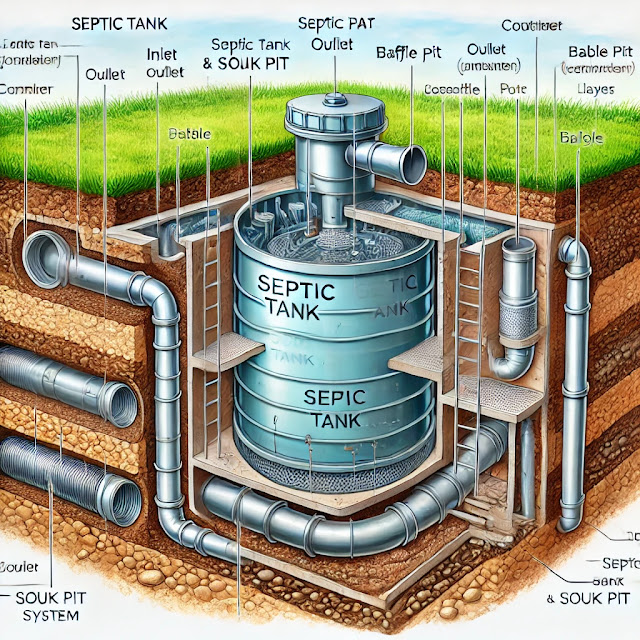Septic Tank and Soak Pit:
Septic tanks and soak pits are vital systems
for managing wastewater in areas without centralized sewage networks.
They are a cost-effective, simple way of both
treating and disposing household waste water that also causes little
environmental pollution.
Therefore,
this article offers an introductory understanding of the practical design and
implementation of septic tanks or soak pits and, using an example design of a
combined system suitable for an ordinary household
What is a Septic Tank?
An
underground chamber, usually airtight and watertight, where the water from
sinks, bathtubs toilets can be held for treatment. Made out of concrete, fiber
glass or plastic its function is to separate solids and liquids so that nautral
processes clean up the wastewater.
Key Features of a Septic Tank
· There are several functions that the Septic Tank
performs well once properly maintained.
· An air-free, confined space: Bacteria in the bottom of
the tank decompose this organic matter.
· Separation of solids: Solids settle to form sludge at
the bottom, while lighter materials like grease float to form scum.
· Effluent discharge: Partially treated water leaves the
tank for a soak pit or drain field where it will be further treated.
Components of a Septic Tank
· Inlet Pipe and Outlet Pipes: Ensures the smooth flow
of water into and out of your tank.
· Baffles: Remove turbulence while separating solids from
liquids.
· Manholes: Inspection and cleaning points.
· Vent Pipe: Releases gases produced when organisms
decompose.
What Is a Soak Pit?
A
soak pit—also called a soakaway, septic tank with field drain, filter bed, or
leach pit—is an underground structure that allows treated waste-water (from the
tank part of this system) to seep out through pores in its base and cocneal
itself completely in surrounding soil. It is a natural and low-cost way to
dispose of effluent safely.
Notes on Key Features of a Soak Pit:
1)
Filtration The soil helpfully takes out impurities as the water filters through
it.
2)
Groundwater Recharge Effluent adds to groundwater levels.
3)
Simple Design It is simple to make and keep up.
Components of a Soak Pit:
-Pocketed
Walls Usually made of bricks, stones, and occasionally precast concrete.
-Gravel
or Sand Stratum: Improves water filtration.
-Cover
Slab Prevents contamination and ensures safety for people.
Designing a Combined Septic Tank and Soak Pit System
A combined system integrates
the septic tank and soak pit to efficiently handle wastewater while minimizing
environmental risks. Below is a detailed design example for a household with
five members.
Step 1: Determine Daily Wastewater Flow
- Average water usage per person: 150 liters/day.
- Total daily flow: 5 people × 150 liters = 750 liters/day.
Step 2: Design the Septic Tank
- Detention Time: To ensure effective treatment, a detention time of 2 days is
recommended.
- Capacity Calculation:
{Tank Capacity} = {Daily Flow} × {Detention Time}
- Tank Capacity: 750 liters/day × 2 days = 1,500
liters.
- Dimensions:
- Length: 2.5 meters
- Width: 1.25 meters
- Depth: 1.5 meters
- Shape: Rectangular with a length-to-width ratio of
2:1.
- Material: Reinforced concrete for durability.
Step 3: Design the Soak Pit
- Effluent Flow: The soak pit should handle 750 liters/day from the septic
tank.
- Percolation Rate: Conduct a soil percolation test to determine how quickly
water can seep into the ground. For sandy or loamy soils, a soak pit is highly
effective.
- Dimensions:
- Diameter: 1.5 meters
- Depth: 2 meters
- Construction:
- Line walls with perforated bricks or concrete rings.
- Add a gravel layer (30 cm) at the base.
- Cover the pit with a concrete slab for safety and
hygiene.
Step 4: Connect the System
- Pipeline: Use a sloped pipeline to connect the septic tank outlet to the soak
pit, ensuring smooth effluent flow.
- Ventilation: Include a vent pipe for the septic tank to allow gas release and
prevent pressure buildup.
The Maintenance of a Combined System
- Septic Tank Desludging Remove sludge every 2-3 years to maintain the tank's capacity
- Inspection Regularly check for cracks, blockages or excessive scum layers. Avoid Harmful Chemicals Do not pour oils, grease or harsh chemicals into the system, as they can disrupt bacterial activity.
- Prevent Overloading Avoid introducing more effluent than the soak pit can handle. Periodic Cleaning Look for sings of clogging or reduced infiltration and clean the pit when necessary Gravel Replacement Replace or wash gravel every 5-10 years to maintain efficiency.
The Benefits of a Combined System
· Cost-Effective Both structures use simple designs and
materials, so they are affordable.
· Environmental Benefits Reduces pollution by treating
wastewater on site.
· Can be expanded for households of different sizes.
· Groundwater Recharge Treated effluent helps to
replenish groundwater levels.
· Low Maintenance Require only periodic checks and
cleaning.
Challenges and Solutions
1. Soils for Its Suitability
Challenge: Clayey or waterlogged soils reduce percolation
efficiency Solution: Conduct a percolation test and, if necessary, use
alternative methods like drain fields. Overloading: Challenge Excessive wastewater
can saturate the soak pit
Solution: Design the system with sufficient capacity and
monitor usage. Septic Tank Leaks
Challenge: Cracks or poor construction can cause groundwater
contamination.
Solution: Use high-quality materials and regular inspections.
Practical Tips for Installation
· Choose the Right Location Ensure that the septic tank
is at least 15 meters from water sources and also 3 meters from the soak pit.
· Use Durable Materials Choose reinforced concrete or
high-quality plastic for lasting value.
· Plan for Accessibility Ensure that both structures can
be easily gotten when they need to be repaired.
· Follow Local Guidelines Like what it is said above,
follow regional regulations about how to treat and discharge wastewater.




Post a Comment